
|
|
|
RECORDS OF THE DANISH LANDSCAPE
A good many superlatives are present on this page where Danskebjerge.dk has gathered some of the topscorers of the landscape of Denmark. Biggest, longest, steepest - you can see it all here.
HIGHEST NATURAL POINT:
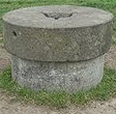
Measuring 170.86 meters above sea level, the top of Møllehøj, close to Ejer Bavnehøj, is considered the highest point in Denmark.
Certain ground points in the same area, Ejer Bjerge, are marginally higher, but they are influenced by human hand (mounds), and the additional height gained through this doesn't count from a geological perspective.
|
DEEPEST VALLEY:
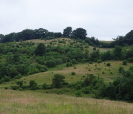
The deepest valley in Denmark is Vejle Ådal. Its sides are 104 metres and 81 metres high respectively. The valley is 2.5 kilometres wide (measured from top to top).
All the largest Danish valleys are located on the eastern side of the Jutland peninsula.
|
BIGGEST SLOPE:
From Aborrebjerg - the highest point of the island of Møn - and down to the Baltic Sea, there is a difference of 143 meters in height. This is Denmark's most significant difference in vertical height, as the distance between the two points is less than one kilometer. Only in nine other Danish places, you'll find an elevation of 100 meters or more within one kilometer.
|
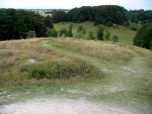
|
MOST SLOPING (LONG) PATH:
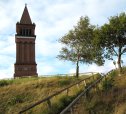
The popular route from the lake of Julsø to the observation tower at Himmelbjerget ('The Sky Mountain') has an elevation of 126 meters, making it the path with most vertical meters in Denmark. The gravel path has a gradient of 13.5 percent in average.
There are, however, some steps at certain places along the stretch, so biking is hard.
|
STEEPEST TERRAIN SURFACE:
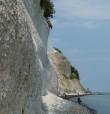
Two phenomena can make a Danish terrain surface extremely steep: Rocks (as found on the island of Bornholm) and cliffs (found at several Danish coasts). Among smoothed surfaces, the most probable winner will be the cliff at Møn, Møns Klint. Due to erosion, the slopes of these cliffs in some cases "lean backwards", thus getting an angle of more than 90 degrees.
|
HIGHEST PLACED BURIAL MOUND:

Among Denmark's ten-thousands of burial mounds, Yding Skovhøj is situated at the highest altitude. The foot of the mound is at 170.77 meters above sea-level, while the point at its top measures 172.54 meters above sea-level. A more precise name is Rodebuske, distinguishing this mound from two others nearby.
|
HIGHEST PLACED CHURCH:

Two churches at each end of the country share first place. The churches of Øster Nykirke in Mid Jutland and Rutsker Kirke on the island of Bornholm are both situated at 130 meters above sea-level. There is a four meter margin down to number 3 which is Ovsted Kirke.
|
HIGHEST PLACED RAILWAY STATION:

The railway station of Jelling is located on the railway line between Vejle and Holstebro. The terrain height of the station is 104 meters above sea-level. Besides, east of Jelling, the railway has the steepest gradient of any existing Danish railway.
|
HIGHEST PLACED GOLF COURSE:

The highest point on the course of Himmelbjerg Golf Club is situated 123 meters above sea-level, making it the highest golf course in Denmark. Number two is Nordbornholms Golfklub at 114 meters, and number three Faaborg Golfklub at 106.
|
LONGEST STAIRWAY:
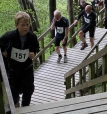
Starting right at the shore of the Baltic Sea, the wooden stairway going up to the Geocenter Møns Klint is the longest of a handful of stairways at the cliffs called Møns Klint.
The Geocenter stairway has almost 500 steps and a total elevation of 100 meters. A few meters from the top, there is another stairway - this one goes to Dronningestolen, adding another 100 steps and around 25 vertical meters to the climb from the beach.
|
STEEPEST STREET:
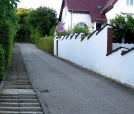
The narrow street Christian Winthers Vej in the city of Vejle is the steepest street in Denmark (among those streets that are open for traffic at both ends).
From the bottom to the top, it has these dramatic data:
Length 380 meters, elevation 59 meters, slope in average 15.5%. The maximum gradient is 25.5%.
|
HIGHEST ISLAND:
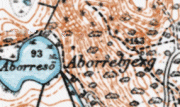
While only the 10th largest island in Denmark, Møn is the highest, with Aborrebjerg reaching 143 meters above sea level. Number two is Nørrejyske Ø - the area north of the Limfjord - which has a terrain point that reaches 136 meters (although Nørrejyske Ø is not always regarded as a true island). Funen (Fyn) and Zealand (Sjælland) are number 3 and 4 with 130 meters and 123 meters respectively.
|
STEEPEST PATH:
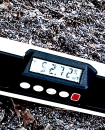
No particular winner of this category, since any significant deviance on the surface may result in almost vertical, very short passages on a path. However, the assessment of Danskebjerge.dk is that runners tend to stop actual running on paths rising more than 40 percent. Cyclists get into trouble already at 30 percent (because of gravity and/or loose surface). On the other hand, mountainbike tracks designed for downhill easily reach a gradient of 50 percent.
|
BIGGEST CLIMB ON MAIN ROAD:

The biggest continuous Danish climb is the stretch of Lyngdalvej-Skovhøjvej at the village of Yding in Mid Jutland. Properties: Length 4050 meters, elevation 125 meters, average gradient 3.1%.
(Certain other climbs in the area have a bigger elevation, but at the same time a very small average gradient.)
|
HIGHEST FIXED POINT:
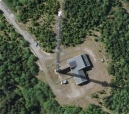
The top of the Rø-sender on the island of Bornholm reaches a height of 431 meters above sea-level - which is a Danish record.
The mast alone, which transmits TV, radio and mobile phone signals, measures 315.5 meters, and in addition, the mast is placed on a high point in the terrain, 115.5 meters above sea-level.
|
BIGGEST WATERFALL:
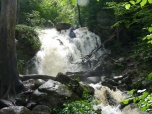
In the valley of Døndalen on Bornholm, you'll find the biggest Danish waterfall, Døndalfaldet. The fall has an elevation of 20 meters in total, of which the vertical fall amounts to 4 meters. The volume of its water flow depends to a large extent on the season and the amount of precipitation.
|
FLATTEST MAIN ROAD:
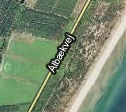
Skagensvej-Ålbækvej - at the East coast of Vendsyssel. Along a stretch of 15.85 kilometers the surface of the road constantly lies at an altitude of 0 to 5 meters above sea-level. The total number of vertical meters on the stretch is less than 20.
|
LOWEST POINT ON DANISH SOIL:
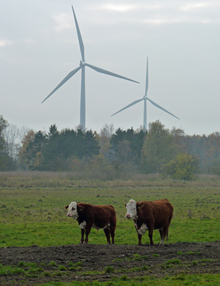
In the landscape created solely by nature, the lowest point is found just around 0 meters above sea-level: at the Danish shores. But in the Lammefjord, the water level has been lowered by means of damming. Thus, here you can step onto old sea bed - without getting your feet wet - at around minus 7.5 meters. In the granite quarry of Rønne, the hole now reaches a depth of minus 39.5 meters (but this is of course a purely man-made hole).
|
Related stuff: Denmark's 10 toughest climbs Highest points in Denmark
|
|

















